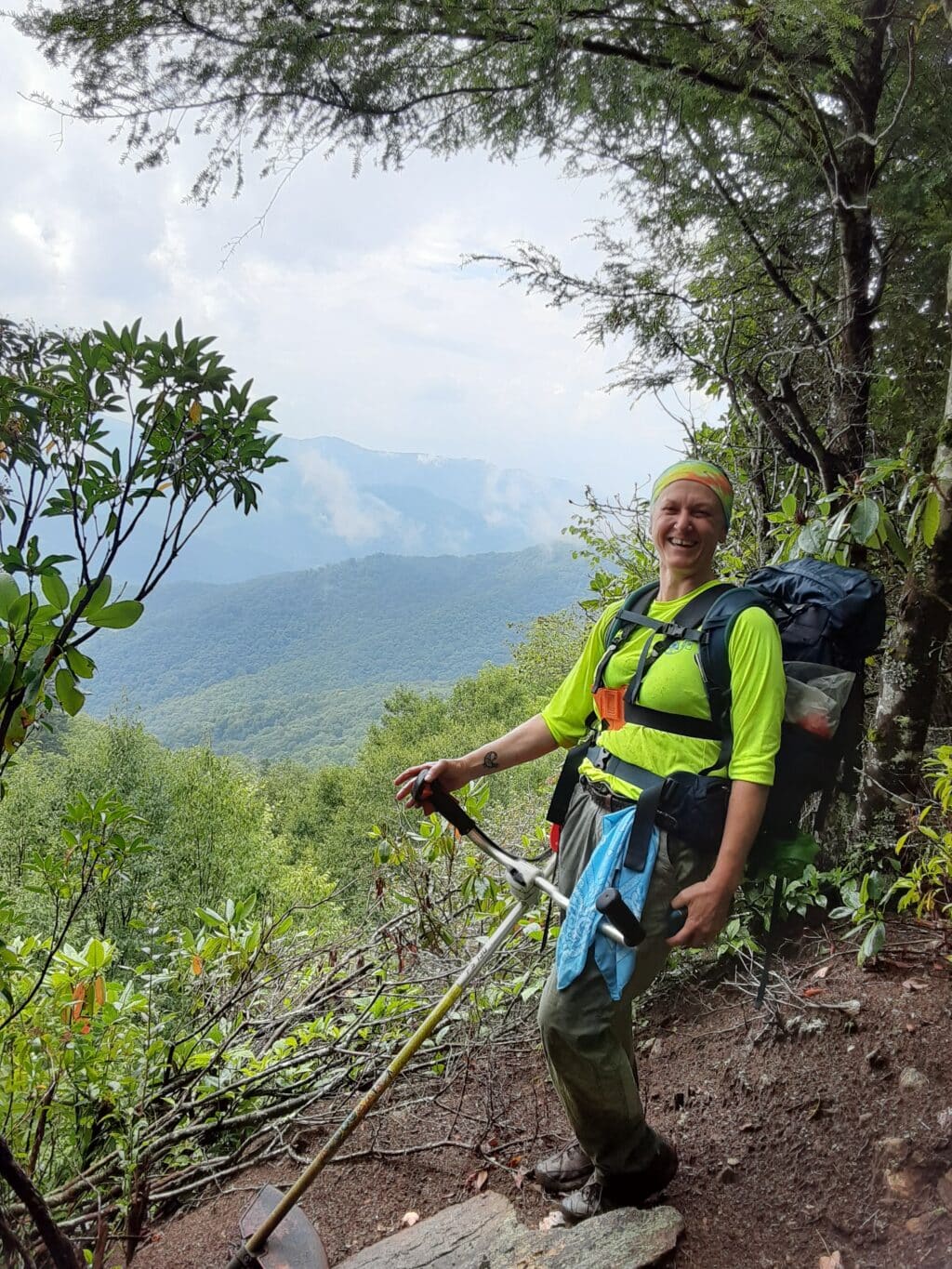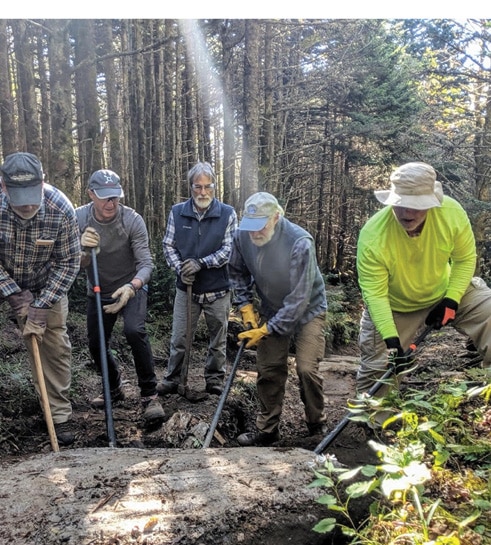Hard-working volunteers maintain trails in the Blue Ridge, and they could use your help.
RETIRED ATTORNEY BOB WIDMAN didn’t know a hazel hoe from a Pulaski several years ago when he started volunteering as part of a weekly trail maintenance crew that helps keep western North Carolina’s hiking trails open. Now he’s an old hand at building steps, clearing water drains, trimming back thick vegetation, and helping clear fallen trees blocking the trail.
He’s also got enough lawyer jokes to keep most of his fellow crew members laughing as they work.
“I always thought park rangers or Forest Service workers cleared the trails,” Widman said, echoing a misconception held by much of the public. “I was never very handy with tools, but these guys are patient and have taught me everything I need to know.”
Widman is part of a crew that goes out most Mondays, year-round, representing both the Carolina Mountain Club from Asheville and Burnsville’s NC High Peaks Trail Association. The crew works trails ranging from the Black Mountains to the Appalachian Trail on the Tennessee border to the Mountains-to-Sea Trail that parallels the Blue Ridge Parkway.
“The scenery is incredible,” Widman said. “It’s almost as good as the camaraderie and the brownies that the Crew Leader’s wife makes for us.”

A typical workday starts with the weekly email sent out by the Crew Leader to let the team know when and where to meet and what the tasks will be. The group usually gathers at a trailhead between 8 and 9 a.m. for a safety talk and distribution of tools.
“No tools or experience necessary,” said High Peaks President John Whitehouse, who doubles as the Carolina Mountain Club’s Monday Crew Leader. “The volunteers only need to bring a sturdy pair of work gloves, wear long pants, and bring water, lunch, and some snacks. We’ll provide all the tools and help them learn how to do the work.”
The group then typically hikes out from the trailhead to the work area, sometimes going a mile or two with a steep climb; other times working only a few hundred yards down the trail. In summer they might weed-eat overgrown sections or trim back vegetation with loppers or handsaws. They also dig out water drains that help stop erosion, sometimes embedding logs to make a berm to channel the water away.
The crews build steps out of logs or rocks on steep and eroded sections and help saw teams clear limbs or whole trees that have fallen and are blocking the path. Volunteer sawyers must take a two-day safety course from the U.S. Forest Service before using chainsaws and must wear safety equipment provided by the clubs.
Whitehouse’s Monday Crew often attracts 12 to 15 volunteers, so they break up into smaller teams to accomplish several different tasks and to keep a safe working distance from each other. The work usually ends at 2 p.m., followed by the hike back to the trailhead.
“We’ve recently been building steps at Mt. Mitchell State Park on a couple of badly eroded trails,” Whitehouse said. “We might have two guys digging out and installing the timbers for the steps, screwing them together with a drill and then drilling a hole for metal rebar that will hold the timber in place. Meanwhile other team members are installing water drains or finding rocks that can be broken up with a sledgehammer to fill in behind the step.”
Whitehouse’s crew also recently hiked several miles up to weed-eat the Black Mountain Crest Trail, one of their most ambitious but badly needed annual tasks. A team of nine workers shared seven weed-eaters, clearing heavy grass and fast-growing vegetation from a couple of miles of the path. The group will take several trips to complete about seven miles of that one trail.
“When we started clearing this trail 10 years ago, it was nearly grown shut with blackberry canes, blueberries, laurel, and rhododendron,” Whitehouse said. “We’ve managed to open it wide enough so that you can hike it now without getting soaked by the vegetation when it’s wet.”
The trail crews are salted heavily with retirees, who often thrive on the social interaction and the feeling of working for a good cause. But as the retirees gradually age out, the clubs are constantly trying to attract new volunteers to replenish the ranks.
“We often see dozens of hikers enjoying the trails we work,” Whitehouse said. “If only 10 percent of them would volunteer with us one or two days a month, it would be a big help. But so many hikers don’t seem to know that it’s volunteers who do almost all the maintenance on these trails.”
Widman says the volunteer work has become one of the most enjoyable parts of his week, something that he looks forward to.
“The only problem is I keep asking for a raise,” he said. “The Crew Leader says he’ll double my salary, but I keep telling him zero times zero is still zero.”
Cover Photo: Trail Crews Work in the Mountains of North Carolina. Photos Courtesy of the Author/carolina Mountain Club







